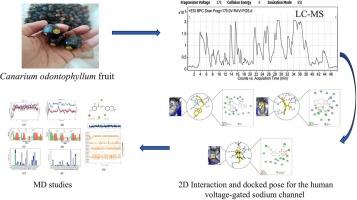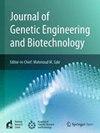Exploration of Canarium odontophyllum fruit phytoconstituents as potential candidates against epilepsy using in silico studies
IF 2.8
Q3 Biochemistry, Genetics and Molecular Biology
Journal of Genetic Engineering and Biotechnology
Pub Date : 2025-08-26
DOI:10.1016/j.jgeb.2025.100561
引用次数: 0
Abstract
Epilepsy is the third most common neurological illness worldwide, affecting over 65 million people. Current antiepileptic drugs (AEDs) are ineffective for about 30 % of epileptic patients. AED use is extremely expensive and associated with adverse effects such as ataxia, nystagmus, and central nervous system depression. Serious quality-of-life changes are another aspect of managing epileptic conditions. A variety of therapeutic plant components, including flavonoids, phenolics, terpenoids, and alkaloids, exhibit a wide range of biological actions, including antibacterial, antioxidant, antiulcer, antineoplastic, anti-inflammatory, antiepileptic, and immunostimulant properties. Because many of them are being researched in modern research to develop an active therapeutic candidate, we resorted to medicinal plants to investigate powerful antiepileptic components. So, in this in silico study, we aimed to identify potential antiepileptic agents from Canarium odontophyllum fruits using molecular docking, molecular dynamics, and ADMET prediction approach. In the present study, the virtual screening was performed on a set of 63 phytocompounds, identified from the hydroalcoholic (70 %) extract of C. odontophyllum fruit using LC-MS (LC-MS-QTOF) analysis, by using molecular docking simulation to examine their binding ability with seven proteins that are responsible for epilepsy. Further, the selected compounds with good binding affinity were subjected to ADMET screening to predict the pharmacokinetic properties, and molecular dynamics testing was done to confirm the outcomes. Our results revealed that C. odontophyllum phytoconstituents showed the strongest binding affinities against all tested enzymes. Moreover, kanzonol B could prominently interact with all tested proteins with moderate to good binding affinity (−6.70 to −10.65 kcal/mol). All top phytoconstituents obeyed Lipinski’s RO5 and drug-likeness properties. These computational studies suggested that the phytoconstituents of C. odontophyllum can serve as potent inhibitors of enzymes responsible for epilepsy. Thus, we recommend further experimental investigations to validate the promising results of the present in silico study.

利用硅芯片研究探索牙齿Canarium odontophyum果实植物成分作为抗癫痫药物的潜在候选物
癫痫是世界上第三大最常见的神经系统疾病,影响到6500多万人。目前的抗癫痫药物(AEDs)对大约30%的癫痫患者无效。AED的使用非常昂贵,并伴有不良反应,如共济失调、眼球震颤和中枢神经系统抑郁。严重的生活质量改变是控制癫痫病情的另一个方面。多种治疗性植物成分,包括黄酮类、酚类、萜类和生物碱,具有广泛的生物作用,包括抗菌、抗氧化、抗溃疡、抗肿瘤、抗炎、抗癫痫和免疫刺激等特性。由于现代研究正在研究其中的许多药物,以开发有效的治疗候选药物,因此我们利用药用植物来研究有效的抗癫痫成分。因此,在本计算机研究中,我们旨在通过分子对接、分子动力学和ADMET预测方法,从Canarium odontophyum果实中鉴定潜在的抗癫痫药物。在本研究中,采用LC-MS (LC-MS- qtof)分析方法,对从牙齿果(C. odontophyllum)果实的水酒精(70%)提取物中鉴定出的63种植物化合物进行虚拟筛选,并通过分子对接模拟来检测它们与7种导致癫痫的蛋白质的结合能力。进一步,选择结合亲和力较好的化合物进行ADMET筛选,预测药代动力学性质,并进行分子动力学测试来证实结果。结果表明,齿龈草植物成分对所有酶的结合亲和力最强。此外,kanzonol B与所有被测蛋白具有中等至良好的结合亲和力(- 6.70至- 10.65 kcal/mol)。所有顶级植物成分都符合利平斯基的RO5和药物相似特性。这些计算研究表明,牙齿草的植物成分可以作为癫痫酶的有效抑制剂。因此,我们建议进一步的实验研究来验证目前在硅研究中的有希望的结果。
本文章由计算机程序翻译,如有差异,请以英文原文为准。
求助全文
约1分钟内获得全文
求助全文
来源期刊

Journal of Genetic Engineering and Biotechnology
Biochemistry, Genetics and Molecular Biology-Biotechnology
CiteScore
5.70
自引率
5.70%
发文量
159
审稿时长
16 weeks
期刊介绍:
Journal of genetic engineering and biotechnology is devoted to rapid publication of full-length research papers that leads to significant contribution in advancing knowledge in genetic engineering and biotechnology and provide novel perspectives in this research area. JGEB includes all major themes related to genetic engineering and recombinant DNA. The area of interest of JGEB includes but not restricted to: •Plant genetics •Animal genetics •Bacterial enzymes •Agricultural Biotechnology, •Biochemistry, •Biophysics, •Bioinformatics, •Environmental Biotechnology, •Industrial Biotechnology, •Microbial biotechnology, •Medical Biotechnology, •Bioenergy, Biosafety, •Biosecurity, •Bioethics, •GMOS, •Genomic, •Proteomic JGEB accepts
 求助内容:
求助内容: 应助结果提醒方式:
应助结果提醒方式:


